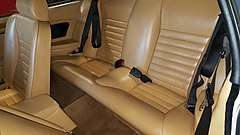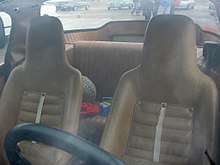2+2 (car body style)

The 2+2 is a version of the coupé car body style that has two small rear seats for children or occasional usage, along with two front seats for the driver and front passenger.[1] For coupés that are sold either with or without rear seats, the versions that include rear seats are often marketed as a "2+2".[2]
Definition

By definition, all cars in the 2+2 category have two front seats and two rear seats. Other common characteristics for 2+2 cars include relatively little room for the rear passengers and a coupé body with two doors.
Although many convertible, targa top and hatchback cars meet the literal definition of a 2+2, they are rarely considered 2+2s.
Usage
Many cars which can be considered 2+2s are described by the manufacturer as such, because the term is most often used to distinguish cars from a 2-seat open version of the same model. Prominent examples are the classic Jaguar E-type fixed-head coupé 2+2, the Lotus Elan 2+2, the Nissan 300ZX 2+2, the Chevrolet Monza 2+2, the 1965–1966 Mustang 2+2[3] and the Pontiac 2+2 models.
The 1965 and 1966 Mustang Fastback was marketed as the "Mustang 2+2", because a fold-down rear seat was included as standard equipment. Where the standard (two-seat) Mustang had a "MUSTANG" emblem, the 2+2 model had a "MUSTANG 2+2" emblem. In 1967, the rear seat became optional, and the "2+2" designation was dropped.
Cars marketed as 2+2
- These are examples, and are not intended to represent a complete list.
- Alfa Romeo Brera
- Alfa Romeo GTV (916)
- Aston Martin DB9
- Aston Martin DBS
- Audi A5/S5/RS5 coupé
- Audi TT
- Bentley Continental GT/GTC
- Bentley Brooklands/Bentley Azure
- BMW 6 Series/BMW M6
- BMW 8 Series
- BMW i8
- Cadillac CTS-V Coupé
- Chevrolet Camaro
- Chevrolet Monza 2+2
- Dodge Challenger
- Datsun 260Z/Datsun 280Z
- Ferrari 330 GT 2+2
- Ferrari 456
- Ferrari California
- Ferrari FF
- Ferrari GTC4Lusso
- Ferrari Mondial
- Ferrari Portofino
- Ford Focus Coupé
- Ford Mustang
- Honda CR-Z
- Honda Prelude
- Hyundai Genesis coupe
- Infiniti G37 coupé
- Jaguar E-Type 2+2
- Jaguar XJS
- Jaguar XK
- Land Rover Range Rover Evoque Coupé
- Lexus RC/Lexus RC F
- Lotus Elan
- Lotus Evora
- Maserati Coupé
- Maserati GranTurismo
- Mazda RX-7
- Mazda RX-8
- Mercedes-Benz 250 SL California coupé
- Mercedes-Benz CL-Class/Mercedes-Benz CL65 AMG
- Mitsubishi 3000GT
- Nissan 180SX
- Nissan 300ZX (Z31 & Z32) 2+2
- Nissan Silvia (S13)
- Nissan Skyline GT-R (KPGC10)
- Opel Cascada/Vauxhall Cascada/Buick Cascada/Holden Cascada
- Peugeot RCZ
- Pontiac Catalina 2+2
- Pontiac Firebird
- Porsche 944
- Porsche 911
- Renault Fuego
- Scion tC
- Subaru Alcyone SVX
- Tesla Roadster 2020
- Toyota 86/Scion FR-S/Subaru BRZ
- Toyota Celica
- Toyota Supra 2+2
- TVR Cerbera
- Volkswagen Eos
- Volkswagen Scirocco
- Volvo C30
- Volvo C70
See also
- Car body style and particularly:
- Car classification
References
- ↑ "Sedan vs. Coupe Cars: Meaning, Definition & Differences". www.automoblog.net. Retrieved 18 March 2018.
- ↑ "ZX History". www.project300tt.com. Retrieved 18 March 2018.
- ↑ "1964 Ford Mustang 2+2". www.themustangsource.com. Retrieved 23 March 2018.